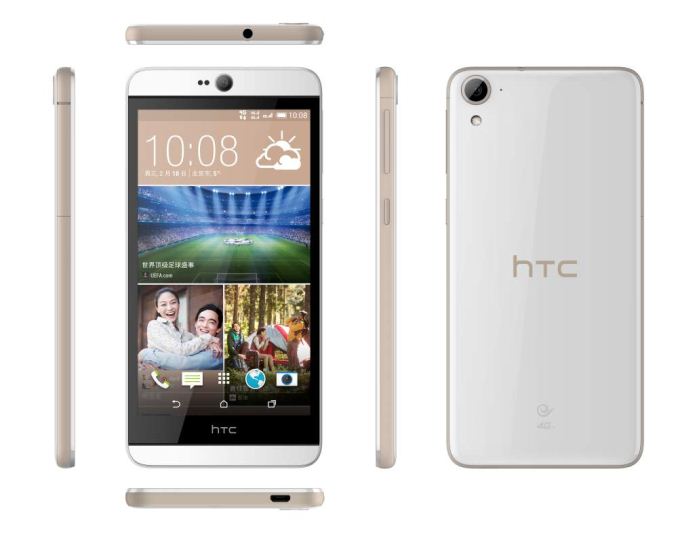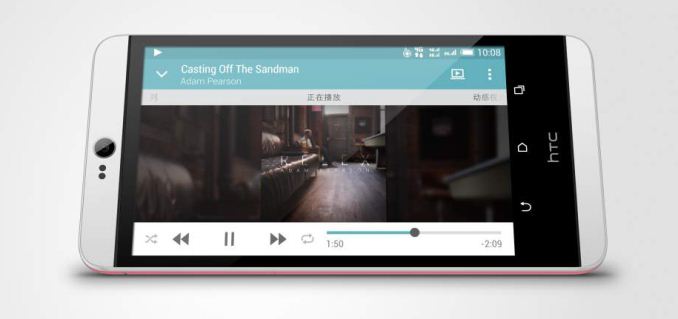HTC Announces the Desire 826
by Brandon Chester on January 6, 2015 4:17 PM EST- Posted in
- Smartphones
- HTC
- CES 2015
- Desire 826

Yesterday at CES, HTC announced the newest device in their lineup of Desire smartphones. Years ago, HTC's flagship devices fell under the Desire brand. In recent years, the Desire brand has been shifted to more budget oriented devices. This new HTC smartphone is the Desire 826, and it follows in the footsteps of the Desire 816 and Desire 820 that came before it. Although it isn't HTC's flagship smartphone, it still has respectable specifications, and in many ways is not far off from today's flagship devices. I've laid out the key specifications of the Desire 826 below.
| HTC Desire 826 | ||||||
| SoC | Qualcomm Snapdragon 615, 4 x Cortex A53 at 1.7GHz + 4 x Cortex A53 at 1.0GHz, Adreno 405 GPU |
|||||
| Memory and Storage | 16GB NAND + MicroSDXC, 2GB LPDDR3 | |||||
| Display | 5.5” 1920x1080 LCD | |||||
| Cellular Connectivity | 2G / 3G / 4G LTE (Qualcomm MDM9x25 UE Category 4 LTE) | |||||
| Dimensions | 158 x 77.5 x 7.99 mm, 183g | |||||
| Camera | 13 MP f/2.2 Rear Facing, 4MP UltraPixel f/2.0 Front Facing or 13MP f/2.0 Front Facing | |||||
| Battery | 2600 mAh (9.88 Whr) | |||||
| Other Connectivity | 802.11 a/b/g/n + BT 4.1, AptX, USB2.0, GPS/GNSS, NFC (in select regions) | |||||
| SIM Size | Nano SIM (Dual SIM SKU available) | |||||
| Operating System | Android 5.0 Lollipop with HTC Sense | |||||
The Desire 826 has a lot in common with the Desire 820 that was released in September 2014. Both devices use Qualcomm's Snapdragon 615 with 2GB of LPDDR3 memory, 16GB of NAND, and 2600mAh (9.88Wh) battery. However, the Desire 826 has a maximum clock speed of 1.7GHz on its high-power A53 cluster, while the Desire 820 was limited to 1.5GHz. Being an Android 5.0 Lollipop device, the Desire 826 will also be 64-bit enabled out of the gate, while the Desire 820 had to operate in 32-bit mode due to a 64-bit version of Android being unavailable. I still believe having two clusters of Cortex-A53s is silly, but HTC weren't the ones making that decision so it's not something I can really fault the phone itself for.
There are some other notable improvements over the Desire 820. The Desire 826 has a significantly sharper display due to HTC's move from 1280x720 to 1920x1080 on the same panel size. The front-facing camera is the other significant difference between the two devices. While the Desire 820 used an 8MP front-facing sensor, the Desire 826 uses a 4MP UltraPixel sensor with an f/2.0 aperture for the front-facing camera in most markets. This should significantly improve low-light camera performance. In certain unspecified markets, the Desire 826 will use a 13MP f/2.0 sensor instead. Like all of HTC's recent devices, the Desire 826 ships with HTC's Eye Experience software for the camera.
The Desire 826 will be available in the Asia-Pacific region by the end of this month, and will expand to other markets afterward. It comes in multiple colors, including but not limited to white, purple, and blue. There is currently no word on what to expect for pricing, but it should be similar to the launch price of the Desire 820.
Source: HTC











40 Comments
View All Comments
Stuka87 - Tuesday, January 6, 2015 - link
First, yes you can scale V/Freq, turbo mode in Intel and AMD chips do this, as do nVidia and AMD GPUs. Its very common.Second, if you looked you would see four cores are 1.7GHz, and four are 1GHz.
saratoga4 - Tuesday, January 6, 2015 - link
They're not the same cores. The A53 is just a logical design for a processor. It is not an implementation, thats left up to the designer and the fab. Depending on your goals, you can optimize for area, power or performance.Synopsis had a good presentation on the work they did with the A7:
http://www.synopsys.com/Services/Documents/pwr-cen...
As you can see, the actual layout has an enormous influence on the power/performance tradeoff. As the A53 is descended from the A7, similar tradeoffs likely apply. If they're aiming for a 70% difference in clock, they have a lot of room to optimize the layout on the low power core for minimal leakage.
tuxRoller - Wednesday, January 7, 2015 - link
Forget multi threading. A typical, modern os uses many, many (kernel) threads at a given time. From handling hardware to timers to the actual programs.It's cheaper to run them on different cores, then shut down the cores, than time share a single, or few, cores.
Of course this requires an excellent scheduler.
tuxRoller - Wednesday, January 7, 2015 - link
Forget multi threading. A typical, modern os uses many, many (kernel) threads at a given time. From handling hardware to timers to the actual programs.It's cheaper to run them on different cores, then shut down the cores, than time share a single, or few, cores.
Of course this requires an excellent scheduler.
Stuka87 - Tuesday, January 6, 2015 - link
The Snapdragon 615 kind of steals the wind from nVidia's sails. At least from a CPU point of view. Same CPU setup, but in a device that will be shipping soon. As opposed to just releasing an SoC with no contracts yet.This phone does have a very "iPhone 6" look to it.
phoenix_rizzen - Tuesday, January 6, 2015 - link
CPU setup is very different between the SD615 and the X1.The SD615 has 8x Cortex-A53 CPUs, configured using big.LITTLE across quad-core clusters. 4x Cortex-A53 at 1.7 GHz (big cluster) and 4x Cortex-A53 at 1.0 GHz (LITTLE cluster). 8 of the same CPU cores, just clocked differently.
The X1 has 4x Cortex-A57 for the big cluster, and 4x Cortex-A53 for the LITTLE cluster. Note the difference in the last number in the CPU core name for each cluster.
Stuka87 - Tuesday, January 6, 2015 - link
Ahh, you are right.tuxRoller - Saturday, January 10, 2015 - link
The snapdragon 808 is the one to look out for. It has, IMHO, the ideal combination of cores. Unfortunately they skimped on the gpu (adreno 418, iirc, but, in practice, it's around adreno 420 levels, but built on a smaller node).Although it shouldn't be neccessary given a power aware scheduler (which STILL isn't good enough in linux), the option to completely prevent certain cores from ever switching on could lead to a better experience. Especially on 4 + 4 big.LITTLE, where you only allow two big cores, and in particular the cores that are farthest apart from one another, to run on the big core side of things. The a53s should be cool enough to not be an issue.
Megatomic - Tuesday, January 6, 2015 - link
Not a bad looking device, it would be a pretty nice upgrade from my Moto X 2013.mczak - Tuesday, January 6, 2015 - link
How are 2 A53 clusters not HTC's fault?There's the Snapdragon 610 which is all but identical except it drops the second A53 cluster.
(I bet though it's the same chip but with the second cluster simply disabled.)
But marketing is all cores, cores, cores. Plenty of phones announced with snapdragon 615 but none with 610...